What Are the Four Stages of Mesothelioma?
The pleural mesothelioma stages indicate how far the cancer has spread. Doctors use this information to determine the mesothelioma prognosis and life expectancy.
Mesothelioma staging plays a major role in whether a patient is eligible for tumor removing surgery.
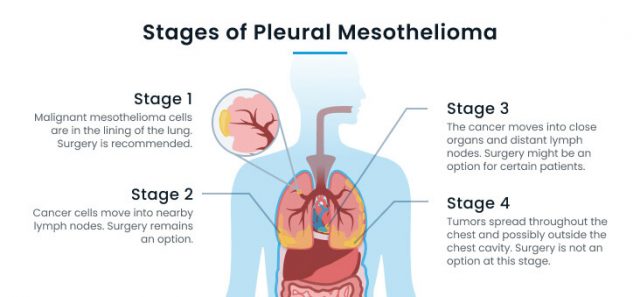
Patients diagnosed with early stage mesothelioma tend to live longer.
Many other factors affect life expectancy, though, and some late-stage patients survive for years with mesothelioma treatment.
Stage 1 Mesothelioma
Pleural mesothelioma starts in a spot outside the surface of one lung. Early stage mesothelioma typically does not cause symptoms, so it is rarely diagnosed in stage 1. Patients fortunate to be diagnosed with mesothelioma this early usually have a more favorable prognosis.
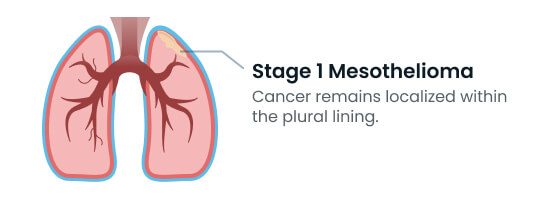
Subdivisions of Stage 1
- Stage 1A
-
Cancer is in one or both layers of the pleura (membrane lining of the lungs) on one side of the chest.
- Stage 1B
-
Cancer is in both layers of the pleura and other nearby tissue on one side of the chest.
Symptoms, Treatment and Life Expectancy
Usually, there are no symptoms associated with stage 1 mesothelioma.
Patients in strong health may benefit from a combination of tumor-removing surgery, chemotherapy and radiation therapy. Immunotherapy and anti-angiogenic therapy might also be recommended.
According to the International Association for the Study of Lung Cancer (IASLC) the median survival rate for stage 1 pleural mesothelioma is 22.2 months with surgery.

Stage 2 Mesothelioma
In stage 2 mesothelioma, cancer cells have spread to nearby tissue on one side of the chest. In addition, mesothelioma cells have spread to nearby lymph nodes.
Symptoms may start to arise in stage 2 pleural mesothelioma, though people often mistake these early signs for cold or flu symptoms.
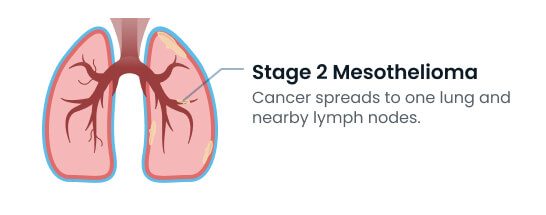
Symptoms, Treatment and Life Expectancy
When symptoms occur in stage 2, patients commonly complain of occasional breathlessness and a mild cough.
While there is a little more cancer spread at stage 2, the primary treatment options are generally the same as stage 1: Surgery, chemotherapy and radiation therapy. Some patients might also receive immunotherapy or other novel therapies.
The median survival rate of stage 2 pleural mesothelioma is 20 months with surgery.
Stage 3 Mesothelioma
At Stage 3, cancer has spread significantly throughout the chest, causing distinct mesothelioma symptoms. Whether doctors recommend surgery depends on how far the cancer has spread and several other factors.
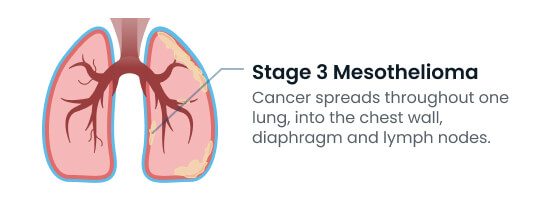
Subdivisions of Stage 3
- Stage 3A
-
Cancer has spread from the pleura into other tissue on one side of the chest. The cancer has also spread to nearby lymph nodes.
- Stage 3B
-
Cancer has spread from the pleura deep into other parts of the chest, or it has spread to lymph nodes on the other side of the chest or above the collarbone.
Symptoms
- Breathlessness
- Cough
- Wheezing
- Chest pain
- Fatigue
Treatment and Life Expectancy
Some patients in stage 3 may be eligible for tumor-removing surgery. But in most cases, doctors recommend chemotherapy, immunotherapy, anti-angiogenic therapy or palliative treatments.
The median survival rate for stage 3 mesothelioma is 17.9 months with surgery.
Stage 4 Mesothelioma
In stage 4 mesothelioma, the cancer has spread throughout the chest and may have metastasized outside of the chest. This means cancer cells have broken away from the original tumor and invaded nearby organs, bones or tissues. It is rare for mesothelioma to spread to distant locations that are far away from the chest.
Stage 4 pleural mesothelioma is very difficult to treat, and symptoms are severe.
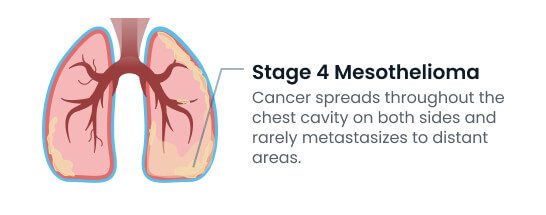
Symptoms
- Difficulty breathing
- Trouble swallowing
- Chest pain
- Fever
- Night sweats
- Fatigue
- Weight loss
- Muscle weakness
Treatment and Life Expectancy
Most patients in stage 4 do not qualify for aggressive treatment and are better served by palliative treatment that controls symptoms and extends survival. These treatments include chemotherapy, immunotherapy, anti-angiogenic therapy and radiation therapy.
The median survival rate for stage 4 pleural mesothelioma is 12 to 14.9 months with treatment.
Mesothelioma Staging Systems
Three systems have been used to stage pleural mesothelioma. Early systems include the Butchart and Brigham systems. Today, the TNM system is used to define pleural mesothelioma stages.
Other types of mesothelioma do not have official staging systems. A staging system is in development for peritoneal mesothelioma, but more data is needed to officially adopt it.
TNM Staging System
This is the most widely used staging system for pleural mesothelioma and it was developed by the International Mesothelioma Interest Group. TNM is considered the most detailed and accurate system for defining cancer stages and mesothelioma metastasis.
- Tumor
-
The first part ranges from T0 to T4, describing tumor size and location.
- Nodes
-
The second part ranges from N0 to N3, describing which lymph nodes are affected.
- Metastasis
-
The third part ranges from M0 to M1, describing whether the cancer has spread through the bloodstream to other parts of the body.
TNM is considered the most detailed and accurate system for defining mesothelioma stages.
Brigham Staging System
The Brigham staging system was developed by Dr. David Sugarbaker during his time at Brigham and Women’s Hospital in Boston.
Sugarbaker developed the system to identify which patients are the right candidates for aggressive surgery. Like the TNM system, it uses four stages.
The first two mesothelioma stages qualify for surgery, while the last two do not qualify for surgery.
Butchart Staging System
The Butchart system is the oldest staging system for pleural mesothelioma. It was developed in 1976 by Dr. Eric Butchart.
It also uses four stages to define cancerous growth and progression. While this system is no longer used, it set the foundation for all future staging systems.



